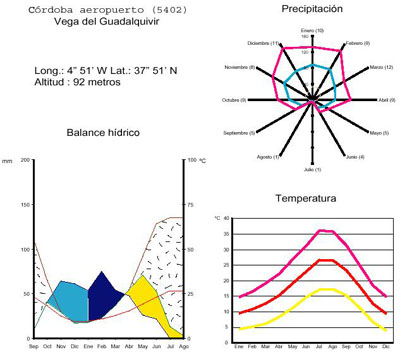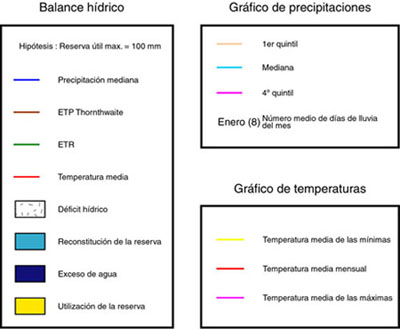Ya en el interior de la región nos encontramos con este tipo de clima, que corresponde al área del interior del valle del Guadalquivir, donde la penetración de la influencia oceánica por el oeste tiene lugar preferentemente en invierno, pero no tanto en verano. En esta última estación tiende a imponerse un régimen de levante en la región, asociado a una fuerte subsidencia del aire generada por la presencia de una manifestación muy intensa del anticiclón de las Azores; en esas condiciones las influencias oceánicas se reducen al máximo y ello explica el carácter muy cálido y seco de los veranos de esta zona. De hecho, este es el rasgo que mejor define lo peculiar de esta región, donde las temperaturas medias de julio y agosto superan los 28°, produciéndose, además, estos elevados valores en virtud de unas temperaturas máximas muy altas, que superan casi siempre los 35° y con una frecuencia nada desdeñable los 40°. Los inviernos, aunque son suaves por la penetración de las influencias oceánicas, son algo más frescos que en las zonas costeras (la temperatura media anual suele descender de los 10°, aunque no suele ser inferior a 6°-7°) y ello determina un aumento de la amplitud térmica anual respecto a los climas mencionados anteriormente.
Figura 1: Gráficos del observatorio de Córdoba.


We can find this climate inside the region, corresponding to the interior side of the valley of the Guadalquivir, where the penetration of the oceanic influence from the West takes place preferently in winter, but not really in summer. In this latter season, an east wind regime tends to be dominant in the region, associated to a strong subsidence of the air generated by the intense pressence of the Azores anticyclone; in those conditions, oceanic influences are reduced to the maximum explaining the very warm and dry character of summers in this region. In fact, this is the feature that better defines the peculiarity of this region, where the average temperatures are over 28° in July and August, producing, also, these high values due to very high maximum temperatures, nearly always over 35° and with an important frequency over 40°. Winters are soft due to the penetration of oceanic influences, anyway they're cooler than in coastal zones (the annual average temperature is usually under 10°, but it usually doesn't descend under 6-7°) and that determines an increase in the annual thermical amplitude respect to previous mentioned climates.
Figure 1: Córdoba's observatory graphics

